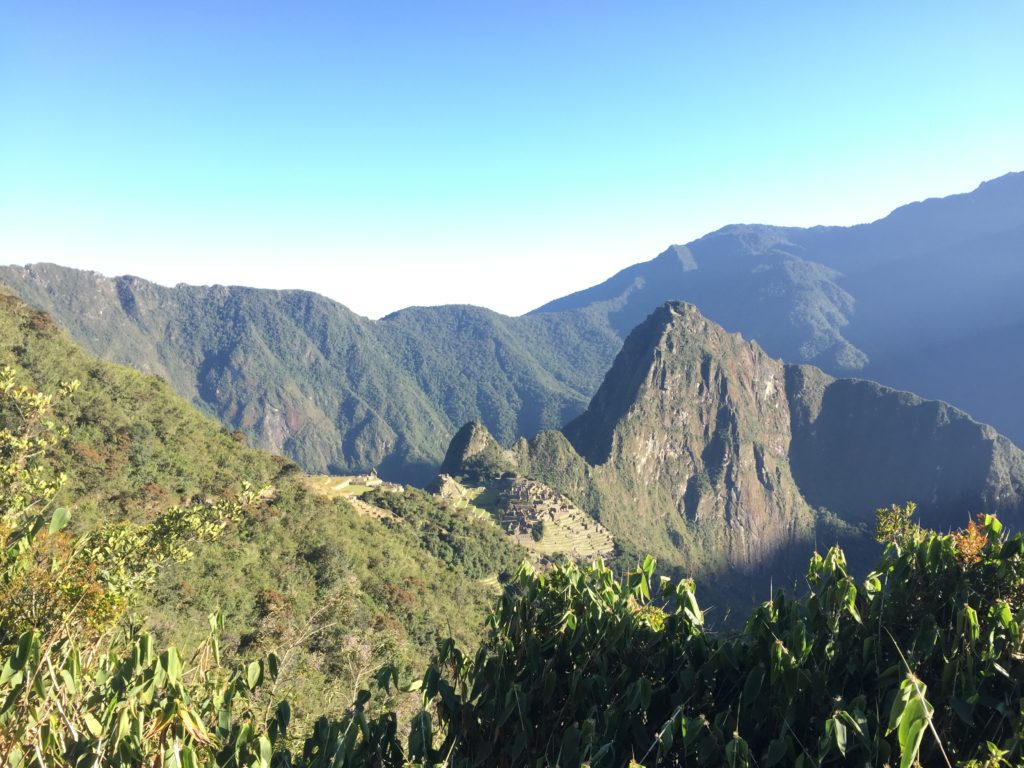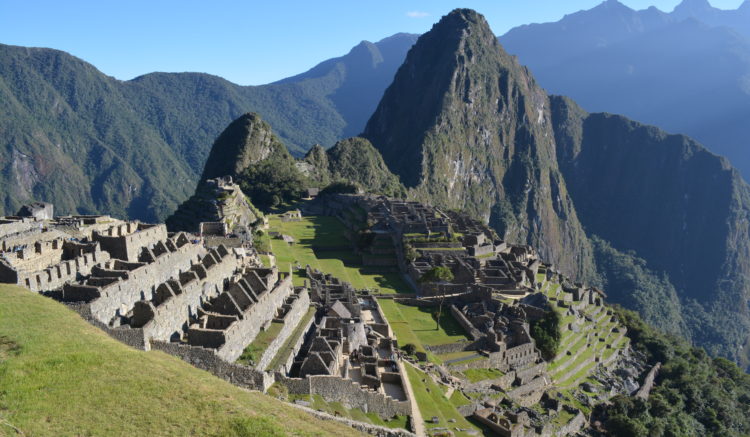Geography & Climate
The Classic Inca Trail (Camino Inca) covers a 43-kilometre (26-mile) trek through the dramatic Andean mountain range, starting at Piscacucho (Km82) and culminating at Machu Picchu, a UNESCO World Heritage site. The trail spans altitudes from 2,600 metres (8,530 feet) in the Sacred Valley to the dizzying heights of 4,200 metres (13,779 feet) at Dead Woman’s Pass. Trekkers need to be prepared for varying terrain: rugged mountain paths, steep stone steps, and ancient Inca routes that wind through cloud forests and high-altitude passes. The best time to hike is during the dry season (May to September), when skies are typically clear, though temperatures can dip below freezing at night, especially at higher elevations.
History & Economics

Machu Picchu
The Inca Trail, culminating at Machu Picchu, is deeply intertwined with Peru’s history and modern economy. Machu Picchu, rediscovered by American explorer Hiram Bingham in 1911, had remained hidden from Spanish conquistadors. Bingham’s find helped to spotlight this marvel of Inca engineering, now one of the most visited archaeological sites in the world and one of the New Seven Wonders.
Machu Picchu and the Inca Trail have become pivotal to Peru’s economy, with tourism creating jobs for locals as guides, porters, and in the hospitality industry. However, the Peruvian government has implemented strict controls, allowing only 500 people per day on the Classic Inca Trail, with permits for the hike needing to be booked well in advance (often six months or more). This quota includes tourists, guides, and porters, meaning only about 250 tourists are granted access per day. Because of the popularity of the Classic Inca Trail and strict controls on numbers through the issue of daily permits, this was one leg of our journey around South America whereby we used a UK Travel Agent – Journey Latin America to make the arrangements for us. While I am sure it could be done more cheaply using local agents, we were also on a reasonably tight schedule which necessitated fixing the dates for the Classic Inca Trail.

Porters on the Camino Inca
Culture, Fellow Travellers, and Porters
Our trek group consisted of 3 Britons (including myself), 2 Argentinians, and 4 Spaniards, along with 2 Peruvian guides and 10 porters, one of whom doubled as a cook. These porters, often from local communities, carried not only their own supplies but our tents, sleeping bags, and food, leaving us to enjoy the stunning scenery with lighter loads. Porters are the unsung heroes of the trek—hauling heavy loads up steep paths while ensuring trekkers are well-fed and comfortable at each campsite. Their strength and endurance were awe-inspiring, and they also took great pride in sharing aspects of their local culture with us. Our small, diverse group of travellers bonded over shared stories, snacks, and the camaraderie that comes from enduring the physical challenge of the trek together.
Getting to Km82 and Returning from Machu Picchu
Our adventure began with a scenic minibus ride from Cusco to Km82 at Piscacucho, the official start of the Classic Inca Trail. The journey took us through the Sacred Valley, winding past traditional Andean villages and vibrant markets. As we neared the trailhead, the imposing peaks of the Andes loomed overhead, adding to the anticipation. After completing the trek, our return to Cusco was via the PeruRail train, departing from Aguas Calientes. The train journey, which follows the course of the Urubamba River, offered a chance to sit back and enjoy the spectacular landscapes through large panoramic windows. The train was modern and comfortable, with options for snacks and refreshments as we watched the Andean highlands slip by.
Aguas Calientes and the Casa Andina Standard
In Aguas Calientes, we stayed at the Casa Andina Standard Machu Picchu, a hotel located right by the river. The sound of rushing water was a constant presence, adding to the tranquil atmosphere. The hotel was comfortable, with modern amenities and an excellent location near the town’s main attractions. After four days of trekking, it was a much-welcomed respite, with cosy rooms and friendly staff ensuring we were well-rested for our early morning return to Machu Picchu.
Day-by-Day Breakdown of the Classic Inca Trail
Day 1: Km82 (Piscacucho) to Huayllabamba (12 km)
The first day started at Km82 near Ollantaytambo, in the Sacred Valley, where the Urubamba River mirrors the shape of the Milky Way according to Inca legend. While this stretch does not follow original Inca paths, it still provided an introduction to the beautiful scenery and local communities that dot the valley. One of the first major Inca sites we encountered was Llactapata, where the terraces and ruins symbolise the three Inca worlds: the serpent (underworld), puma (earth), and condor (heavens). The day’s hike was relatively gentle, ending at the Huayllabamba campsite (3,000 m).







Day 1 Camino Inca
Day 2: Huayllabamba to Pacaymayo (8.8 km)
Day two marked the toughest part of the trek, with a steep ascent to Dead Woman’s Pass (Warmiwañusca) at 4,200 metres. The ancient Inca stone steps, combined with the altitude, made for a challenging climb. At the top, the views of the Andes were breathtaking, though the descent into the Pacaymayo valley was equally strenuous. The day ended at the Pacaymayo campsite (3,600 m), with everyone feeling the effects of high-altitude trekking.








Day 2 Camino Inca
Day 3: Pacaymayo to Winay Wayna (13.4 km)
The third day was the longest but perhaps the most rewarding, with a series of ancient Inca sites along the way, including the intricately designed Sayacmarca, perched dramatically on a cliffside. Later, we passed through the cloud forest to the impressive ruins of Puyupatamarca, known as the “Town in the Clouds.” This day’s trek offered a rich blend of Inca history and stunning natural beauty, finishing at the Winay Wayna campsite, located near the end of the Inca Trail.













Day 3 Camino Inca
Day 4: Winay Wayna to Machu Picchu (5 km)
On the final day, we began hiking at 3:30 am to ensure our porters could make their way to the train station at Aguas Calientes. After passing through the last control point at 5:00 am, we climbed to Intipunku (Sun Gate), the gateway to Machu Picchu. This steep ascent involved a near-vertical scramble, adding to the excitement of the final stretch. As we reached the Sun Gate, the early morning mist began to lift, revealing the spectacular sight of Machu Picchu spread out below us. It was a breathtaking moment and the culmination of four days of intense trekking.






Day 4, Camino Inca
| The Importance of Machu Picchu to the Incas Machu Picchu’s exact function remains somewhat mysterious, but it is believed to have been a royal estate for Inca emperors, particularly Pachacuti, who likely commissioned its construction in the mid-15th century. The site was carefully chosen, both for its strategic location and its spiritual significance. Nestled between the sacred peaks of Huayna Picchu and Machu Picchu Mountain, it is thought that the Incas viewed the city as a place of worship and a retreat for nobility. The alignment of the site’s structures with astronomical events, like the winter solstice, points to its role as an observatory as well. Moreover, the terraces and advanced irrigation systems demonstrate the Incas’ mastery of agriculture and their ability to thrive in such rugged, mountainous terrain. |
Road and Shuttle to Machu Picchu
The journey from Aguas Calientes to Machu Picchu itself involves a thrilling 30-minute shuttle bus ride along a narrow, winding road that zigzags its way up the mountain. The road is flanked by sheer drops on one side and thick jungle on the other, and as the bus climbs, glimpses of distant peaks and the surrounding valleys heighten the sense of anticipation. The buses depart regularly from the town square, providing quick and convenient access to the site. Though the ride is somewhat nerve-wracking due to the tight bends and steep inclines, it serves as a prelude to the awe-inspiring views awaiting at the top.







Machu Picchu
Machu Picchu: Full Exploration
Machu Picchu, the crowning glory of the trek, is a marvel of Inca engineering and architecture. The site’s layout blends seamlessly with the surrounding mountains, embodying the Inca’s deep connection to nature. Upon arriving, visitors follow a one-way system through the ruins, designed to prevent overcrowding and protect the ancient stonework. Key landmarks include the Temple of the Sun, with its impressive stonework, and the Royal Palace, showcasing the finest example of classic Inca construction. The Intihuatana, a carved stone that may have served as a sundial or ceremonial centrepiece, sits in a prime location, offering panoramic views of the surrounding valleys. A second day at the site allowed us to explore further and revisit some of our favourite spots from the previous day, delving deeper into the history and significance of this remarkable city.

Sunrise at Machu Picchu
One of the most magical experiences of Machu Picchu is watching the sunrise over the ancient city. One of the advantages of walking the Classic Inca Trail is that on Day 4 you get to the Sun Gate as the sun rises, which is very difficult to experience without carrying out the Classic Inca Trail. As the sun slowly rose, it cast a soft golden light over the mist-shrouded ruins, illuminating the stone terraces and temples. The interplay of light and shadow brought the city to life in a way that’s hard to describe—a serene, almost otherworldly atmosphere descended over the site. As the day brightened, the iconic silhouette of Huayna Picchu became more prominent, creating a picture-perfect moment. It’s a must-do for anyone visiting Machu Picchu, offering a rare opportunity to see the site before the crowds arrive.






Machu Picchu
Environmental Challenges & Management
Machu Picchu and the Inca Trail are subject to strict environmental regulations to preserve both the cultural heritage and the fragile ecosystems. Tourist numbers on the Classic Inca Trail are capped at 500 per day, and the trails and campsites are closely monitored for erosion and degradation. Similarly, Machu Picchu itself operates a one-way walking system and timed entry tickets to manage the large numbers of daily visitors. There are concerns about the long-term sustainability of the site, given its popularity, and plans are continually evolving to balance access with conservation. Despite these measures, the natural wear on stone steps and ruins, along with environmental degradation from foot traffic and waste, remain challenges.





Llamas at Machu Picchu
Markets and Aguas Calientes
At the base of Machu Picchu is the bustling town of Aguas Calientes, where markets are full of souvenirs, local crafts, and textiles, including alpaca wool clothing. The market is a hub of activity, with vendors selling everything from handmade jewellery to Andean musical instruments. The town is also a great place to relax after the trek, with thermal baths and a variety of restaurants offering both local and international dishes. It’s a place where trekkers unwind after the intensity of the Inca Trail, recounting their experiences over a meal.
Final Thoughts
The Classic Inca Trail is a journey of both physical endurance and cultural discovery, culminating in one of the most awe-inspiring historical sites on earth. Machu Picchu’s grandeur, combined with the sense of accomplishment after four days of trekking at altitude, makes the experience unforgettable. The camaraderie built along the way, with fellow travellers and the local porters who make the trek possible, adds depth to the adventure. The Peruvian authorities have done a commendable job managing the environmental impact while allowing trekkers to immerse themselves in this historic journey. The trail remains a life-changing experience for those fortunate enough to walk in the footsteps of the Inca.
Dates: 05/07/2018 to 10/07/2018 – Revised 04/11/2024
